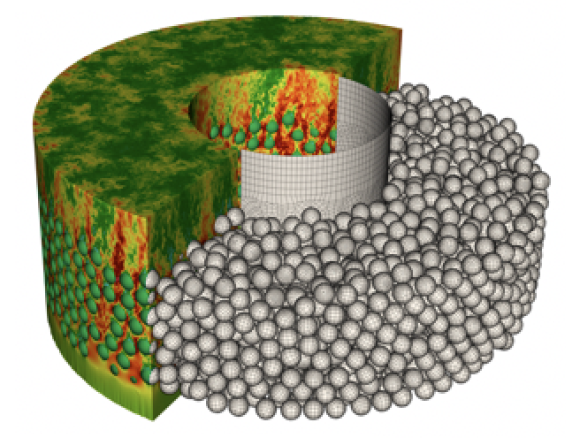

Misun Min CV [PDF]
Computational Mathematician
Mathematics and Computer Science Division
Argonne National Laboratory
9700 S. Cass Ave, Argonne, IL 60439 Office: 240 TCS Building, Room 1-1411
Phone: (630) 252-5380, Fax: (630) 252-5986, Email: [email protected]
My primary research focuses on developing efficient, fast, and accurate numerical algorithms based on high-order discretizations using spectral element (SE) and spectral element discontinuous Galerkin (SEDG) approaches for solving turbulent flows, electromagnetic waves, nanoparticles, charge transport, and quantum electrodynamic problems. It includes developing efficient time discretization algorithms with explicit, implicit, semi-implicit approaches and preconditioning techniques.
DOE-ECP Co-Design CEED (Center for Efficient Exascale Discretizations)
- Argonne/CEED Team makes substantial progress on the development of high-order algorithms for helping exascale application problems and GPU/CPU-based high-performance simulation software for existing advanced platforms and future HPC architectures.
- Significant Contributors: Stefan Kerkemeier (ANL), YuHsiang Lan (ANL), Paul Fischer (UIUC/ANL), Elia Merzari (Penn State/ANL), Ananias Tomboulides (AUTH/ANL), Aleks Obabko (ANL),
as well as several Ph.D. students, Pablo Brubeck, Kento Kaneko, Malachi Phillips, Thilina Rathnayake, Lukas Spies, PingHsuan Tsai - we initiated several important algorithmic works during their Argonne internship periods.
- Algorithmic Development: Steady fluid solvers, Steady thermal solvers, incompressible Navier-Stokes and RANS (Reynolds-Averaged Navier-Stokes) solvers, PNP solvers
- Software Development: Nek5000, NekRS NekBench, gslib
- Our software packages run on from laptop to the most advanced computing architectures including OLCF Summit (V100), Cray Tulip (MI100), and Theta-GPU (A100), capable of full application runs for 60 billions problem sizes, using the full machine of Summit CPUs and GPUs.
- Related Applications: We have been actively working with multiple application teams regarding on Nuclear Reactors (ExaSMR/NEAMS), Wind Energy (ExaWind), Urban (Urban), COVID19 research
- Links: CEED Publications, Advanced Simulation Workshop ASW2020
DOE Applied Math Reseasrch: Computational Electromagnetics and Charge Transport Modeling
- Algorithms: Spectral element discontinuous Galerkin and spectral element methods
- Software Development: NekCEM
- Related Applications: Nanoparticle, 2D Materials, Quantum Electrodynamics, Ion Transport
- Contributors (current): YuHsiang Lan (ANL), PingHsuan Tsai (UIUC)
- Contributors (former): Josh Wilson (U Minnesota), Matthew Otten (Cornell), Ying He (Purdue), Jing Fu (RPI)
Recent Highlight Images

Nek5000/NekRS simulations for turbulent flows past 1568 pebbles at Reynolds number 10,000 using a half million 9th-order spectral elements (380 million grid points).
The simulation was run using 150 V100 GPUs on OLCF's Summit, performed by YuHsiang Lan, ANL.

The image shows turbulent flows past 3344 pebble in an annulus, performed on Summit GPUs, by YuHsiang Lan, ANL.
The mesh is generated by recently developed Voronoi-cell based all-hex meshing tool developed by our team. Pebble beds are being considered for a variety
of next-generation reactor technologies, including molten-salt cooled reactors and very high temperature gas reactors.

We developed a characteristic-based spectral element method for moving-domain problems (Patel et al. 2019)
and demonstrated Nek5000 simulation for the TCC III engine model illustrated in the image. [full movie] by Saumil Patel, ANL.
Argonne Nek team has been working with researchers at ETH Zurich (Giannakopoulos et al. 2019) and ANL’s Energy Systems Division
(under support from DOE’s Vehicle Technologies Office) on detailed studies of turbulence in the IC engine cycle. [full movie] by George Giannakopoulos, ETH Zurich.

Turbulent flows around Lake Point Tower and Chicago downtown block. Detail of our team's work at this link